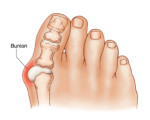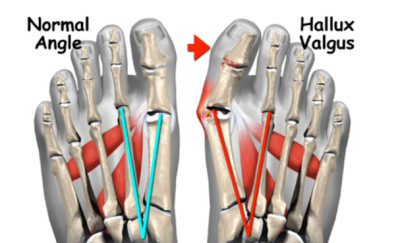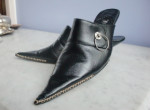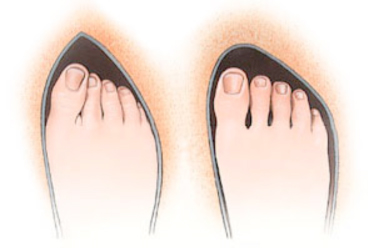What Is A Bunion?

A bunion is a problem that can develop due to hallux valgus, a foot deformity. The term “hallux valgus” is Latin and means a turning outward (valgus) of the big toe (hallux). The bone which joins the big toe, the first metatarsal, becomes prominent on the inner border of the foot. This bump is the bunion and is made up of bone and soft tissue.

What Causes Bunions?

By far the most common cause of bunions is the prolonged wearing of poorly fitting shoes, usually shoes with a narrow, pointed toe box that squeezes the toes into an unnatural position. High heel shoes place excessive pressure onto the front of the toes and are also a cause of bunions. Bunions also may be caused by arthritis or polio. Heredity often plays a role in bunion formation. But these causes account for only a small percentage of bunions.
A study by the American Orthopaedic Foot and Ankle Society found that 88 percent of women in the U.S. wear shoes that are too small and 55 percent have bunions. Not surprisingly, bunions are nine times more common in women than men.
Can Bunions Be Prevented?
Bunions often become painful if they are allowed to progress. But not all bunions progress. Many bunion problems can be managed without foot surgery. In general, bunions that are not painful do not need surgical correction. For this reason, orthopaedic foot surgeons do not recommend “preventive” surgery for bunions that do not hurt; with proper preventive care, they may never become a problem.

Bunion pain can be successfully managed in the vast majority of cases by switching to shoes that fit properly and don’t compress the toes. Your orthopaedic surgeon can give you more information about proper shoe fit and the types of shoes that would be best for you.
Follow these general points of shoe fit:
- Do not select shoes by the size marked inside the shoe. Sizes vary among shoe brands and styles. Judge the shoe by how it fits on your foot.

- Select a shoe that conforms as nearly as possible to the shape of your foot.
- Have your feet measured regularly. The size of your feet change as you grow older.
- Have both feet measured. Most people have one foot larger than the other. Fit to the largest foot.
- Fit at the end of the day when your feet are the largest.
- Stand during the fitting process and check that there is adequate space (3/8″ to 1/2″) for your longest toe at the end of each shoe. Make sure the ball of your foot fits well into the widest part (ball pocket) of the shoe.
- Do not purchase shoes that feel too tight, expecting them to “stretch” to fit.
- Your heel should fit comfortably in the shoe with a minimum amount of slippage.
- Walk in the shoe to make sure it fits and feels right. (Fashionable shoes can be comfortable.)
Some shoes can be modified by stretching the areas that put pressure on your toes. Splints to reposition the big toe and orthotics (special shoe inserts shaped to your feet) also may relieve pain. For bunions caused by arthritis, medications can be prescribed to reduce pain and swelling.
Looking For A Reliable Foot & Ankle Orthopaedic Specialist?
Fast Medical Attention, Transparent Fees
Make an appointment for comprehensive care for your Foot & Ankle problems!
